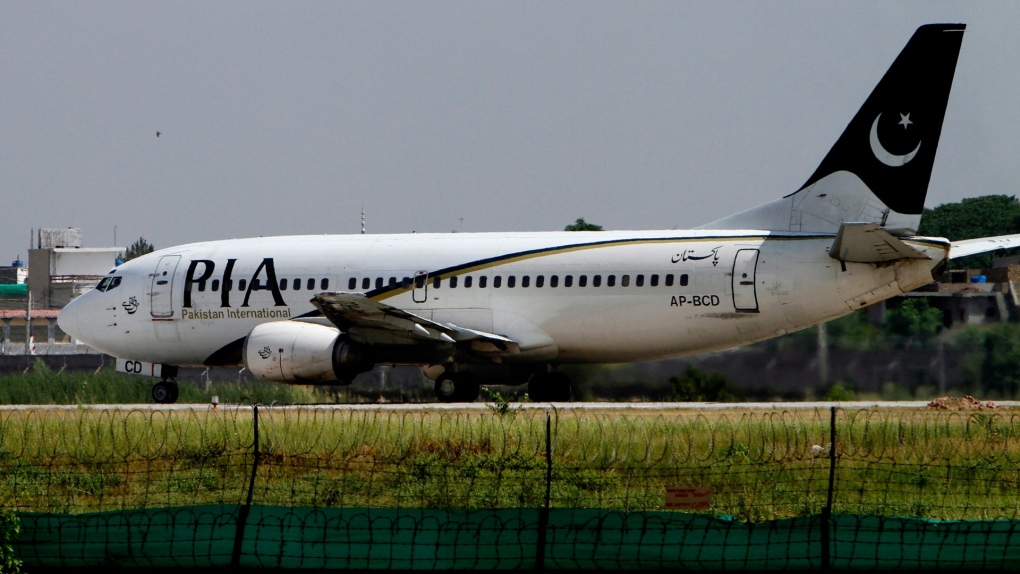Several flight attendants from Pakistan have gone missing after landing in Canada
Typically, Pakistan International Airlines (PIA) flight attendants who arrive in Toronto stay at a hotel overnight, meet back up with their crew the next day and then fly to their next destination.
But increasingly often, PIA attendants aren’t showing up, the airline says. According to PIA, at least eight flight attendants disappeared over the last year and a half.
They have abandoned their jobs and are believed to have sought asylum in Canada, a spokesperson for the government-owned airline says.
Increased occurrences
Abdullah Hafeez Khan said at least eight flight attendants “have gone missing” after flying to Pearson International Airport in Toronto. He said these incidents have been happening over the last 10 years, but are now occurring more frequently.
“Since probably October of 2022, the number of the people that have opted asylum has increased tremendously,” Khan said in a video interview with CTVNews.ca from Karachi, Pakistan, where the airline is based.
“None of those crew members that disappeared in the last one-and-a-half years have come back. So they were granted asylum for one way or the other, and that probably has encouraged others to do so.”
The missing employees were fired immediately and lost their company benefits, Khan said.
Why did they flee?
Khan said he could only speculate as to why the flight attendants would flee.
The Canadian government underscored the volatile situation in Pakistan, warning in a travel advisory of a “high threat of terrorism,” along with threats of civil unrest, sectarian violence and kidnapping.
“The security situation is fragile and unpredictable,” the Canadian travel advisory reads. “Incidents are typically attributed to extremism, ethnic divisions, sectarian strife, regional political disputes and the situation in neighbouring Afghanistan.”
It added that many deaths and injuries have occurred from bombings, shootings and other terrorist attacks at a wide range of targets.
Since Khan isn’t in contact with any of the missing employees, he says, he assumes they decided to seek asylum in Canada for economic and social reasons.
“So I naturally assumed that all of them have been given asylum because I don’t think they would be living there illegally,” he said, adding they may already have family connections in Canada who can support them.
 In this June 8, 2013, photo, a Pakistan International Airlines plane moments before take off from the Benazir Bhutto airport in Islamabad, Pakistan. (AP Photo/Anjum Naveed)
In this June 8, 2013, photo, a Pakistan International Airlines plane moments before take off from the Benazir Bhutto airport in Islamabad, Pakistan. (AP Photo/Anjum Naveed)
‘PR crisis’
Khan called the flight attendants’ disappearances a “PR crisis” for PIA that is “bad” for business amid a crew shortage.
The airline is in talks with the Canada Border Services Agency (CBSA) and Pakistani law enforcement agencies to potentially create a “legal safeguard” to curtail flight crew from seeking asylum, he said.
When asked about the PIA flight attendants’ disappearances, Erin Kerbel, spokesperson for Immigration, Refugees and Citizenship Canada, said the department couldn’t comment on specific cases due to privacy legislation.
In response to questions about PIA’s claim that discussions are underway about the issue, a spokesperson for the CBSA said it could not confirm any information.
“The Canada Border Services Agency does not provide comment or details on specific individuals, including any discussions that would take place with airline companies, as an individual’s border and immigration information is considered private and protected by the Privacy Act,” Maria Ladouceur said in an email to CTVNews.ca.
Since the crew members’ disappearances, Khan said, the airline has “done numerous things to curtail that.”
For instance, the airline is only staffing Toronto-bound flights with crew members who have “established linkages” in Pakistan, such as children, spouses or parents, as well as those who have worked in the organization for more than 15 years.
The airline avoids sending to Toronto those who are single or don’t have established family ties in Pakistan, he said.
Khan said he and the airline are no longer in contact with the flight attendants because, they discovered, they usually change their phone numbers soon after disappearing in Toronto.
Who disappeared?
The PIA flight attendants who vanished in Canada are seasoned pros in their late 30s or 40s, some of whom have worked for the airline for as long as two decades, Khan said.
“There was never any sign from them that they would seek something like that,” he said. “So that is something that is bothering us in the matter because working with people who have been working with you for a long time and then something happens like this is pretty unexpected.”
In one of the latest cases in February, the crew members were waiting to take the bus back to the airport from the hotel in Toronto and one of the flight attendants didn’t show up, Khan said.
The airline was unable to reach the flight attendant on her cellphone or hotel landline so, Khan says, they asked hotel management to check if she was OK.
“When the crew went there, she left her uniform there with a note saying, ‘Thank you PIA,'” Khan said, which he interpreted as a genuine sentiment of gratitude for her more than 15 years of service with PIA rather than a taunt.
Khan said the crew members who disappeared were “family values people” who had good careers in Pakistan.
Asylum policies
Individuals can make a refugee claim in Canada at a port of entry upon arrival or online if they are already in Canada, according to the Canadian government’s website.
Canadian immigration or border officials will determine if the person is eligible for a hearing before the Immigration and Refugee Board. All claimants must undergo health and security screenings, the government says.
If eligible to make a claim in Canada, refugee claimants can access social assistance, education, health services, emergency housing and legal aid pending a decision on their claim. Most can apply for a work permit after a medical examination.
View original article here Source









